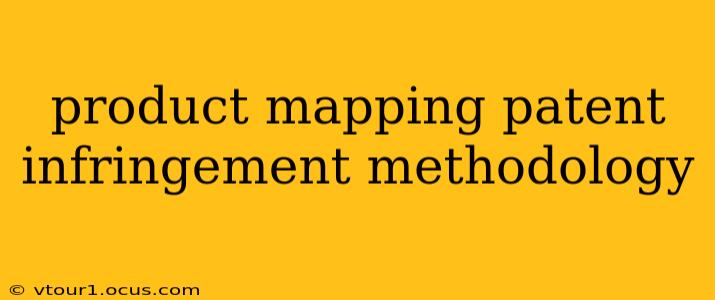Patent infringement is a complex legal issue, and determining whether a product infringes on a patent requires a meticulous and systematic approach. Product mapping plays a crucial role in this process, providing a visual and analytical framework to compare the accused product with the claims of the asserted patent. This article outlines a comprehensive methodology for assessing potential patent infringement through product mapping, addressing common questions and concerns.
What is Product Mapping in the Context of Patent Infringement?
Product mapping, in the context of patent infringement, is a systematic process of visually representing the features and functionalities of a product. This visual representation is then compared to the claims of a patent to determine whether the product incorporates the patented invention. It's essentially a detailed breakdown of the product's design, components, and operations, allowing for a precise comparison with the patent claims. This methodology helps streamline the analysis and makes complex information more accessible and understandable.
How Do I Conduct a Product Mapping Exercise?
Conducting a thorough product mapping exercise involves several key steps:
-
Detailed Product Dissection: Begin by completely disassembling or thoroughly examining the accused product. Document every component, its function, and its interaction with other components. Photographs, diagrams, and schematics are invaluable tools in this process.
-
Patent Claim Analysis: Carefully analyze the claims of the asserted patent. Identify the key elements and limitations described in each claim. Understanding the scope and limitations of the patent claims is critical to accurately assessing infringement. Consult with a patent attorney to ensure a thorough understanding of claim construction.
-
Feature-by-Feature Comparison: This is the core of the product mapping process. Systematically compare each feature of the accused product to the elements recited in the patent claims. Create a matrix or table that clearly outlines this comparison. Identify any discrepancies or differences.
-
Identifying Potential Infringement: Based on the feature-by-feature comparison, determine whether the accused product incorporates all the limitations of at least one claim of the asserted patent. If so, there is a potential for infringement. Note that this is a preliminary assessment, and a legal opinion is necessary for a definitive conclusion.
-
Documentation: Meticulously document every step of the product mapping process. This documentation will be crucial if the matter proceeds to litigation. Include all diagrams, tables, analyses, and supporting evidence.
What are the Key Elements of a Patent Claim?
Patent claims define the scope of the patent protection. Key elements often include:
- Independent Claims: These claims stand alone and define the broadest scope of the invention.
- Dependent Claims: These claims depend on an independent claim and add further limitations.
- Means-Plus-Function Claims: These claims define an element as a "means for performing a specific function."
- Specific Limitations: These are detailed descriptions of particular features, materials, or processes that must be present for the claim to be infringed.
How Can I Determine if My Product Infringes a Patent?
Determining whether your product infringes on a patent is a complex legal question requiring expertise in patent law. While product mapping helps identify potential infringement, it's not a substitute for legal counsel. A qualified patent attorney can provide a comprehensive analysis of the patent claims and the accused product to offer an informed legal opinion.
What are the Consequences of Patent Infringement?
Consequences of patent infringement can be severe and include:
- Injunctions: Court orders prohibiting the manufacture, sale, or use of the infringing product.
- Monetary Damages: Payment of compensation for the infringement, potentially including lost profits and royalties.
- Legal Fees: Significant costs associated with litigation.
What Resources are Available to Help Me Understand Patent Infringement?
Several resources can help you understand patent infringement:
- USPTO Website: The United States Patent and Trademark Office provides substantial information on patents and patent law.
- Legal Professionals: Consulting with a patent attorney is crucial for navigating the complexities of patent infringement.
- Industry Associations: Many industry associations offer resources and educational materials on intellectual property rights.
This methodology provides a structured approach to analyzing potential patent infringement using product mapping. Remember that this is a complex legal area, and professional legal advice is always recommended. This information should not be considered legal advice and is for educational purposes only.
